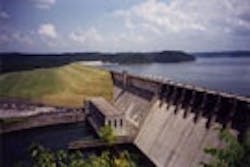Lake Cumberland's Wolf Creek Dam in Danger
The U.S. Army Corps of Engineers has released a final environmental impact statement regarding repairs to Wolf Creek Dam in Kentucky. The forum will be open for public comment on the report through Jan. 22.
The statement noted that high lake levels are causing dam failures so enormous that they outweigh potentially negative environmental effects. The Corps suggested that lowering Lake Cumberland's water level would reduce stress on Wolf Creek Dam.
Hydropower, water supply, recreation, water quality, fish and wildlife management, threatened and endangered species and navigation could suffer if water levels are lowered. The report, therefore, outlines seven alternatives to lowering and maintaining a reduced pool.
The first is a no-action alternative, which would maintain the lake at normal operational guidelines. Water levels would be at about 723 ft during the summer and down to 690 ft by October.
A second option involves maintaining Lake Cumberland's pool height at 680 ft, the lake's current "flatline" elevation. This is a preferred alternative but would have severe consequences on aquatic resources, coldwater fishery, water quality, historic properties, hydropower and economics. The Corps' Natural Resources staff estimated that at least a 50% recreation visitation drop and an entire loss of the lake's coldwater habitat could occur if this route is chosen.
Maintaining the lake's pool height at 650 ft is a third option. Although this alternative would almost entirely eliminate risk and protect Wolf Creek Dam, it would eliminate potable water supplies and fire fighting ability in the lake area.
Other options include keeping pool height at an adjustable elevation between 685 and 700 ft; managing the Cumberland River system in accordance with an interim operating plan, also a preferred option; maintaining pool height at 610 ft, an option that has been eliminated due to its effects on hydropower intakes; and constructing a new roller-compacted dam downstream of the existing dam, also eliminated due to construction restraints.
The report also featured public comments from a scoping letter and 14 responses to a draft environmental assessment released in October.
Wolf Creek Dam has experienced seepage problems since its 1952 construction. Diligent monitoring has made it clear that the dam is at high risk and needs dam safety rehabilitation work. Current repairs will take seven years to complete and cost approximately $300 million. More than 4,447 gal of grout has been pumped into the dam's foundation, according to the latest repair report.
The Corps' report said that while it is unlikely that Wolf Creek Dam will fail, such an event would be "catastrophic" to residents and the local economy.
To view the full environmental assessment, visit www.lrn.usace.army.mil/wolfcreek/documents.htm.
Source: The Herald-Citizen
